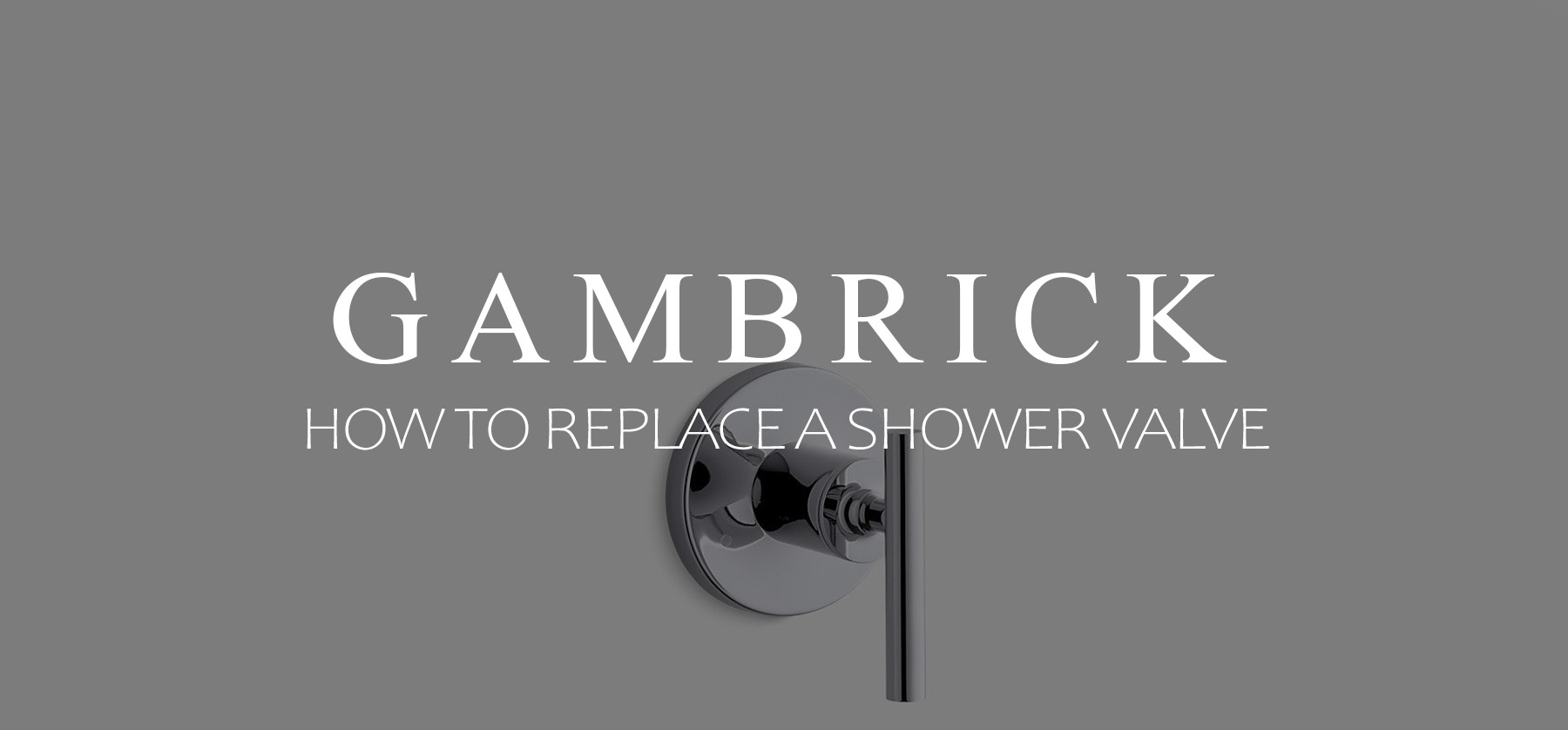How To Replace A Shower Valve
Shower valves are plumbing fittings designed to control water flow and temperature in the shower. They include a cover which keeps water from penetrating behind the wall and protects the valve. Shower valves is connected to a handle which user turns to control water. New shower valves, when properly installed, can make showering more enjoyable by reducing temperature and pressure fluctuations. When shower valves go bad, they can leak, seize, or cause sudden temperature and pressure changes. This can be a real problem if scalding or freezing water suddenly sprays you while in the shower. In this article we’ll explain how to replace a shower valve if it goes bad.
Luckily, most shower valve issues can be fixed by simply replacing the shower valve cartridge and not the entire valve. This is essentially the inner working part of the valve. It can be removed and replaced while the exterior valve assembly and water lines remain in place. While this is a serious issue, most handy homeowners can fix it themselves as a weekend DIY project.
However, if the exterior valve assembly and/or water pipes show signs of rust and/or corrosion, you may need to contact a professional.
Shower valve cartridges usually break because of corrosion or a ring failure which causes leaks. Replace the part immediately to prevent the leak from getting worse. A small drip can soon become a flood of water inside the wall. This can expensive quick because changing the entire shower valve usually means replacing water lines, wall board, tile and grout too.
Getting Started
The first thing you need to do is determine the size and type of shower valve and cartridge you need to change, because most brands will have a variance in stems and splines. They’re typically not interchangeable. Moen, Delta, Kohler are just a few manufacturers that make shower valves. And to make things more complicated, different models made by the same manufacturer sometimes use a different cartridge.
Whenever I have to change a shower valve, I find out what model shower valve I’m dealing with and then contact my local plumbing supply. They’ve always been able to look up the correct cartridge for me. You could also look it up online or contact the manufacturer.
You may need to remove the shower valve cartridge and take it with you to a local home improvement store or plumbing supply house to find the correct replacement part. During this time, make sure the water to the shower remains off to prevent water damage.
Tools & Materials You’ll Need To Replace A Shower Valve Cartridge
Replacing a shower valve cartridge is something you can do yourself, but there are some basic tools and materials you’ll need.
- Drop Cloth: Covering the tub with a drop cloth or plastic sheet is a good idea. It helps keep the area clean.
- Screwdrivers: Bring a Phillips and Standard head screwdriver in a few different sizes. 4 to 6 inches long is generally fine.
- Pliers: I always bring a standard and needle nose pliers. Needle nose pliers are used to remove the cartridge but a standard pliers comes in handy too.
- Allen Wrench Set: Most shower valve handles are secured with a small screw you remove with an Allen Wrench. Sizes vary so get a set.
- Angle Grinder Or Hacksaw: Used for changing the hole size.
- Shower Valve Cartridge: You’ll need a new shower valve cartridge to replace the old one once you remove it.
- Retainer Clip: Holds the shower valve cartridge in place.
- Silicone Caulk: Apply silicone caulk around the valve trim after you re-install it to prevent leaks.
- WD40: Great for loosening hard to turn screws.
- Paper Towels: My go to product for cleaning up.
- Utility Knife: A good knife with fresh blades comes in handy for all sorts of things like scraping off old caulk or grime.
- Caulk Gun: Used to seal the trim plate with silicone caulk after installation.
How To Change A Shower Valve Cartridge Step By Step
Changing a shower valve cartridge is a fairly easy DIY project if your handy and have the right tools. They generally take about 20-30 minutes to remove and replace. Make sure you have everything you need before you get started or you’ll be running back and forth to the store all day.
The most important thing is having the correct shower valve cartridge. If the new valve cartridge isn’t correct, you may have to order the right one and wait for it to arrive. This could leave you without a shower for a while.
Keep all removed parts and screws in one place to use them again when needed.
1. Block The Shower Drain
Before I work on shower plumbing I always block the drain first. Covering the drain helps prevent screws, washers, 0-rings and other small parts from getting lost. I like to use some painters tape to cover the drain. A cloth or plastic could get kicked aside, but tape will stay in place. And it won’t damage the tubs finish.
2. Use A Drop Cloth To Protect The Shower Or Tub
Lay a drop cloth in the shower or tub to block the drain, catch falling parts and protect the surface. Tarps prevent screws, washers, and other small parts from dropping down the drain and keep the area clean. They can also prevent damage to the tubs finish if you drop something.
3. Remove The Shower Handle
The shower valve is located behind the handle, cover and wall. In order to access the shower valve, the handle or handles need to be removed first.
- If the shower has a single handle, look for a very small set screw that can be removed with an Allen wrench.
- Plastic, glass, or faux-crystal decorative handles will typically have a small removable cover over the set screw. Pry off the cover with a small flat head screwdriver to expose the screw. Generally set screws hidden behind a cover use a Phillips head.
Once the set screws are found and/or exposed, use a screwdriver or Allen wrench to remove the screw and then the handle. Set the shower handle and set screw aside where you won’t lose them. You’ll need them both when putting the handle back together.
4. Remove & Clean The Trim Plate
The trim plate is the flat backing piece that sits behind the handle. It covers up the shower valve assembly and the hole in the shower wall. The trim plate seals the hole from water, if the plate wasn’t there, or isn’t sealed properly, water would leak behind the wall. Once the handle is off you can remove the trim plate.
The trim plate is secured to the valve assembly with two screws. Typically they have a Phillips head. Simply remove the screws and pull off the trim plate over the valve stem.
- Make sure to keep track of the screws. You’ll need them when it’s time to re-install the plate.
- Scrape off old caulking with your utility knife.
- Clean off the trim plate and shower handle with your knife, a cleaner and some paper towels.
In some rare cases, the shower valve cartridge can be accessed after removing just the handle. In this case, the trim plate does not have to be removed.
If you like natural cleaners, try soaking the trim plate and handle in some white vinegar. It’ll remove soap scum and other grime. An overnight vinegar bath will often make bathroom fixtures look like new again.
5. Turn The Water Off
The water supply to the shower is typically controlled by two water stops located on either side of the shower valve cartridge. They can be turned off with a screwdriver. This isolates the shower valve from the rest of the water in the home. By turning these two screws, no water will flow into the valve cartridge which makes it possible to remove. This is a huge benefit because you can leave the water supply on for the rest of the house.
If you can’t locate the water stops on your shower valve assembly, you’ll have to turn the water off to the entire home using the main shut-off valve.
After turning off the the main water supply, turn on a nearby faucet to release pressure still inside the line. You can also flush a few toilets. This drains water still sitting in the lines. If your home is a 2-story, turn on faucets downstairs. This will suck water down below the shower so it won’t leak when you remove the valve cartridge.
6. Inspect & Prepare The Area
Once the trim plate is removed you can inspect the size of the hole in your wall. Compare the size of the hole with the size of the shower valve cartridge. If the hole isn’t big enough to fit the cartridge or retainer clip through, you’ll have to make it bigger. This is where the angle grinder or hacksaw are needed.
If the shower valve cartridge can’t be removed because the hole in the shower wall is too small to remove the retainer clip or shower valve cartridge, use a hack saw or an angle grinder to make the hole bigger. Cut the tiles or shower wall just enough to remove the clip or cartridge. Make sure the hole is still small enough to fit entirely behind the trim plate.
If the shower valve cartridge, water stops, and retainer clip can be freely accessed, there is no need to expand the hole.
- Use a pencil to draw around the trim plate. Never cut past this line or the trim plate will not fit over the hole. I like to stay at least 1/4 inch off the line.
- Next, draw the minimum amount of wall you need to cut in order to remove the cartridge.
- Then, cut the area you need to remove very carefully with the grinder or hacksaw.
Make sure you cover the tub and/or shower with a tarp before cutting.
Be careful as you work, you don’t want to damage the tub, tiles, glass or shower walls. You also don’t want to damage the shower valve assembly or the water lines supplying the valve. They’re very easy to cut with a grinder or hacksaw.
I don’t recommend using a reciprocating saw. It’s too easy to lose control and cut the valve or water lines.
7. Remove The Shower Valve Retainer Clip
The retainer clip is a small piece of metal that’s located on top of the shower valve assembly to secure the cartridge. It prevents the cartridge from becoming loose or sliding out of position.
The clip is easy to remove with a set of needle-nose pliers. Grip it with the pliers and pull it up and out of the shower valve.This is why the size of the hole matters. if the hole is too small to remove the clip, you won’t be able to pull out the cartridge.
If the retainer clip is in good condition, it can be reused. Although most new shower valve cartridges also come with a new retainer clip.
If the clip is corroded and hard to pull off, spray it with a little WD-40 first. This should loosen it up a bit. You can also try wiggling it a little as you pull.
8. Pull The Shower Valve Cartridge Out
Use a standard size pliers to grip the shower valve stem and slowly pull the cartridge out of the assembly. Pull it straight out towards you and not on an angle.
The cartridge should slide out without a problem, but if the cartridge is stuck, use some WD40. Spray the cartridge and try wiggling it as you pull.
After removing the cartridge, inspect the shower valve assembly to make sure it’s in good condition. If there are signs of severe rust or corrosion, consider replacing the entire shower valve assembly and the surrounding pipes.
If the hole is too small to remove the shower valve cartridge, make it bigger with your hacksaw or angle grinder. Just make it big enough to remove the cartridge. And make sure not to cut a bigger hole than the trim plate can cover.
9. Install A New Shower Valve Cartridge
Once the old cartridge is out and the shower valve assembly is inspected and found to be in good condition, the new shower valve cartridge can be installed. Simply slide it in and install the clip.
Both the new valve cartridge and retainer clip should slide in without a problem. If they don’t you probably have the wrong part.
Use a standard pliers to slide in the cartridge and a needle nose for the clip.
10. Turn The Water On & Test For Leaks
Once the new shower valve cartridge is in place and held in place by the clip, turn the water on and look for leaks.
- If your valve has water stops, reverse them with a screw driver to turn the water flow on.
- If your valve does not have water stops, turn the main water shutoff back on. Make sure to turn off all the faucets you turned on previously to drain the water lines.
Wipe down the valve assembly with a paper towel to ensure that it’s completely dry. Wait a few minutes after the water is turned on and wipe again. If you find water on your towel there’s a leak.
Turn off the water again and check for problems with your install. Double check that your using the correct shower valve cartridge and clip, this is a common cause of leaks.
11. Install The Trim Plate & Shower Handle
Slide the trim plate over the shower valve stem and secure it with two screws. Then install the handle or handles with the set screws.
12. Wrap Up
Clean up the drop cloth and any other debris and remove it from the shower or tub. Then uncover the drain.
Test the shower handle or handles to make sure they properly control the flow and temperature of the water.
As long as everything’s working properly, you’re just about done. As a finishing touch, apply silicone caulking around the trim plate to prevent water from seeping behind the shower wall.
Summary: How To Replace A Shower Valve
Shower valves are plumbing fittings designed to control water flow and temperature in the shower. They include a cover which keeps water from penetrating behind the wall and protects the valve. Shower valves is connected to a handle which user turns to control water. New shower valves, when properly installed, can make showering more enjoyable by reducing temperature and pressure fluctuations. When shower valves go bad, they can leak, seize, or cause sudden temperature and pressure changes. This can be a real problem if scalding or freezing water suddenly sprays you while in the shower. In this article we’ll explain how to replace a shower valve if it goes bad.
Luckily, most shower valve issues can be fixed by simply replacing the shower valve cartridge and not the entire valve. This is essentially the inner working part of the valve. It can be removed and replaced while the exterior valve assembly and water lines remain in place. While this is a serious issue, most handy homeowners can fix it themselves as a weekend DIY project.
However, if the exterior valve assembly and/or water pipes show signs of rust and/or corrosion, you may need to contact a professional.
Shower valve cartridges usually break because of corrosion or a ring failure which causes leaks. Replace the part immediately to prevent the leak from getting worse. A small drip can soon become a flood of water inside the wall. This can expensive quick because changing the entire shower valve usually means replacing water lines, wall board, tile and grout too.
If you have any questions or comments about how to replace a shower valve cartridge, email any time.





















